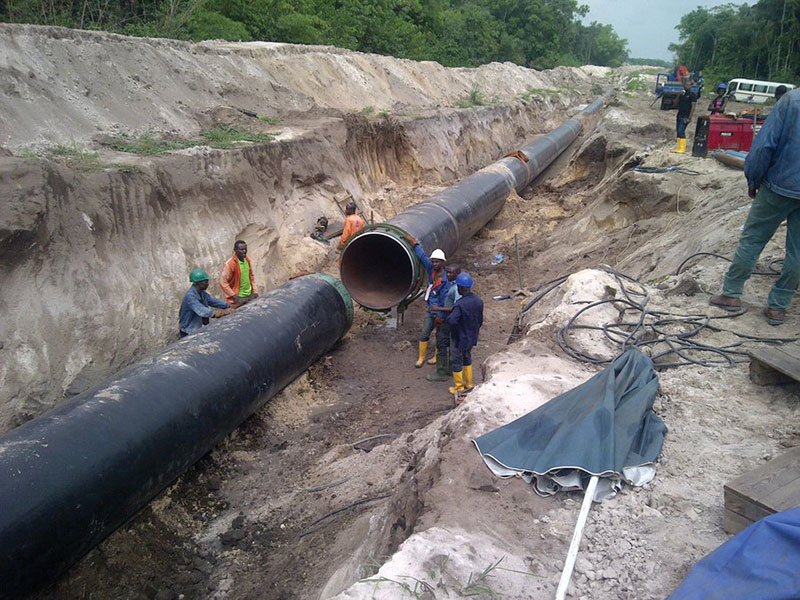August 2020, Vol. 247, No. 8
Features
Nigeria’s New Pipeline Project Is Never Done Until It Is Done
By Shem Oirere, P&GJ Africa Correspondent
For oil- and gas-rich Nigeria, no infrastructure project is done until it is done.
Numerous governmental promises and policy pronouncements typically mark the signing of construction contracts, which can easily convince an observer that the project is about to kick off according to plan.
Unfortunately, the country’s pipeline industry is not following the plan.
The litany of ambitious and expensive energy sector projects that are way behind schedule, or have yet to go through preliminary development phases, is long. The 81-mile (130-km), 48-inch (1,200-mm) Obiafu-Obri Kom-Oben (OB3) gas supply pipeline is the latest example.
For years, Nigeria’s proven reserves of more than 187 Tcf of natural gas has remained under-utilized despite the country pumping nearly $30 billion into sustaining the expensive off-grid, diesel-powered generators to supply electricity. The expense is caused by the inadequate gas pipeline network to convey the resource from gas fields in the Niger Delta.
With the approval of the Gas Master Plan in 2008, Nigeria launched an ambitious journey to scale up gas production with a target of 11,000 million standard cubic feet per day (MMscf/d) by 2018, 15,000 MMscf/d by 2023 and 30,000 MMscf/d by 2043 to meet the demand by power-generating stations and envisaged industrial establishments.
The launch of the $700 million OB3 project in 2012, to supply gas produced within Nigeria’s territory of the eastern network system to the country’s western network system, was intended to enable a solid gas grid to provide the much needed link between natural gas-producing fields and the electricity demand hubs.
In theory, this would entice increased investment by both domestic and international investors in the midstream and downstream gas sectors. However, the gas pipeline, which has a gas capacity of 2,000 MMscf/d, has been delayed for nearly three years, initially due to financing hurdles and recently due to difficulties completing a horizontal directional drilling (HDD) under the River Niger.
The hitch forced state firm Nigeria Gas Transmission Company (NGTC), which owns the project, to hand over this component of the project to Chinese contractor China Petroleum Pipeline Construction Company (CPP) and Nigeria’s Brentex Petroleum Services Limited, which specializes in manufacturing 16- to 60-inch (406- to 1,524-mm) LSAW (longitudinal submerged arc-welded) pipes for the oil and gas industry.
Initially, the OB3 project was set for completion in 2017, before it was pushed back to 2019, then the first half of 2020. That date was recently pushed back to the first half of 2021.
Nigeria’s former Petroleum Resources Minister Emmanuel Kachikwu said that although the contracts had been awarded, “There was need for cost of the redesigning to seek the Executive Council’s (Cabinet’s) approval so that there will be enough funds to execute the project.”
Directional Difficulties
Early this year, reports indicated a contractor had been unable to run the 48-inch pipeline in a drilled 1.2-mile (2-km) pilot hole on the designed path under the Niger River, hence, a delay in completing the project. The reports were not clear at what stage the process stalled – whether it was at the reaming or pipeline placement phase.
Nestoil Limited, an engineering, procurement and construction services provider, was previously awarded the first component of the OB3 project involving 40 miles (64 km), starting from the western part of Nigeria.
Simeon Tor-Agbidye, general manager for Business Development, indicated in 2017 that Nestoil had deployed HDD technology to resolve the challenge of poor terrain in the laying of gas pipelines under the Niger and Ashe Rivers, respectively.
“Coming (starting) from the west, we had some of the most difficult terrains crossing rivers,” he said. “It is almost 2 kilometers and looks small, but the way it is done is not an easy feat,” he said of the deployment of the HDD technology.
According to Tor-Agbidye, by March 2017 the company had “completed the crossing of the Ashe River and currently are looking into the crossing of the Niger River.”
But curiously, two years later, in August 2019, the Nestoil Group’s Executive Director Chukwueloka Umeh told a Nigerian newspaper, “Currently we are supposed to do horizontal directional drilling [HDD] to cross the pipeline under the river Niger, which is about 2 kilometers.”
“It’s never been done in this part of the world for the size of that pipeline, but as I speak the HDD equipment has been covered with water, so we [are] helpless,” he reportedly said.
The entry of CPP into the OB3 gas pipeline project may have been foreseen as early as 2017, when Tor-Agbidye argued against assigning any challenging portions of the project to foreign contractors, saying, “There is no need for any company to give a pipeline contract to a foreign company because we can do everything on the pipeline.”
The OB3 project component undertaken by Nestoil starts from the intermediate pigging station at Umukwata in Delta State and terminates at Oben Node in Edo State, according to a project brief.






Comments